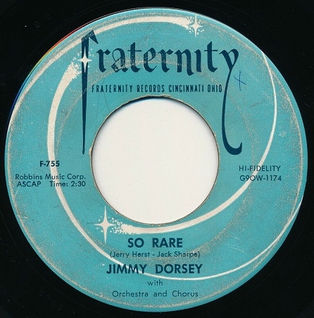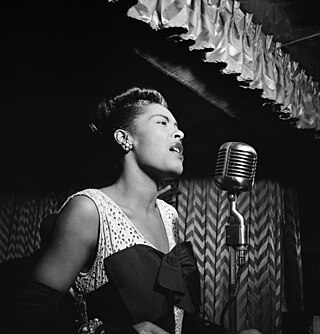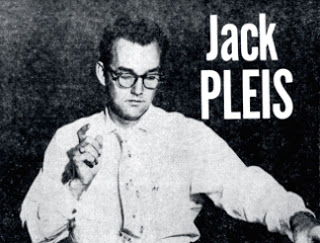Related Research Articles

Decca Records is a British record label established in 1929 by Edward Lewis. Its US label was established in late 1934 by Lewis, Jack Kapp and Milton Rackmil, who later became American Decca's president too. In 1937, anticipating Nazi aggression leading to World War II, Lewis sold American Decca, and the link between the UK and US Decca label was broken for several decades. The British label was renowned for its development of recording methods, while the American company developed the concept of cast albums in the musical genre.
RCA Records is an American record label owned by Sony Music Entertainment, a subsidiary of Sony Corporation of America.
"Mack the Knife" or "The Ballad of Mack the Knife" is a song composed by Kurt Weill with lyrics by Bertolt Brecht for their 1928 music drama The Threepenny Opera. The song tells of a knife-wielding criminal of the London underworld from the musical named Macheath, the "Mack the Knife" of the title.

"Secret Love" is a song composed by Sammy Fain (music) and Paul Francis Webster (lyrics) for Calamity Jane, a 1953 musical film in which it was introduced by Doris Day in the title role. Ranked as a number 1 hit for Day on both the Billboard and Cash Box, the song also afforded Day a number 1 hit in the UK. "Secret Love" has subsequently been recorded by a wide range of artists, becoming a C&W hit firstly for Slim Whitman and later for Freddy Fender, with the song also becoming an R&B hit for Billy Stewart, whose version also reached the top 40 as did Freddy Fender's. In the UK, "Secret Love" would become the career record of Kathy Kirby via her 1963 remake of the song. The melody bears a slight resemblance to the opening theme of Schubert's A-major piano sonata, D.664.
"Blue Tango" is an instrumental composition by Leroy Anderson, written for orchestra in 1951 and published in 1952. It was later turned into a popular song with lyrics by Mitchell Parish. Numerous artists have since covered "Blue Tango".
"Slow Poke" is a 1951 popular song.
"Moments to Remember" is a 1955 popular song about nostalgia recorded by Canadian quartet The Four Lads. The song was originally written by Robert Allen and Al Stillman for Perry Como but was turned down by Como's management.
"My Heart Cries for You" is a popular song, adapted by Carl Sigman and Percy Faith from an 18th-century French melody. The song has been recorded by many singers, the most successful of which was recorded by Guy Mitchell which reached No. 2 on the Billboard chart in 1951.
"Sixteen Tons" is a song written by Merle Travis about a coal miner, based on life in the mines of Muhlenberg County, Kentucky. Travis first recorded the song at the Radio Recorders Studio B in Hollywood, California, on August 8, 1946. Cliffie Stone played bass on the recording. It was first released in July 1947 by Capitol on Travis's album Folk Songs of the Hills. The song became a gold record.
"Wake the Town and Tell the People" is a popular song with music by Jerry Livingston and lyrics by Sammy Gallop, published in 1955. This song is a wedding day number complete with the chorus imitating the sound of wedding bells, as well as the sounds of the real chimes.
Leo F. Reisman was an American violinist and bandleader in the 1920s and 1930s. Born and reared in Boston, Massachusetts, United States, Inspired by the Russian-American violinist Jascha Heifetz, Reisman studied violin as a young man. After being rejected by the Boston Symphony Orchestra, he formed his own band in 1919. He became famous for having over 80 hits on the popular charts during his career. Jerome Kern called Reisman's orchestra "The String Quartet of Dance Bands".
"It Isn't Fair" is a popular song written by Richard Himber, Frank Warshauer, and Sylvester Sprigato and published in 1933. Isham Jones and His Orchestra had a hit with it the same year.
"Lies" is a popular song with music by Harry Barris and lyrics by George E. Springer. It was published in 1931.
"That's My Desire" is a 1931 popular song with music by Helmy Kresa and lyrics by Carroll Loveday.

Merry Christmas is a Christmas-themed compilation album by Bing Crosby that was released in 1945 on Decca Records. It has remained in print through the vinyl, CD, and downloadable file eras, currently as the disc and digital album White Christmas on MCA Records, a part of the Universal Music Group, and currently on vinyl as Merry Christmas on Geffen Records. It includes Crosby's signature song "White Christmas", the best-selling single of all time with estimated sales of over 50 million copies worldwide. The album was certified 4× Platinum by RIAA for selling over 4 million copies in United States. The original 1945 release and subsequent re-releases and re-packages spent a total of 39 weeks at no. 1 on the Billboard pop albums chart.
This is the discography of recordings by Duke Ellington, including those nominally led by his sidemen, and his later collaborations with musicians with whom Ellington had generally not previously recorded.

"So Rare" is a popular song published in 1937 by composer Jerry Herst and lyricist Jack Sharpe. It became a no. 2 chart hit for Jimmy Dorsey in 1957.
Lorraine DeAngelis, known professionally as Lola Dee, also known as Lola Ameche, was an American singer who recorded for the Mercury and Columbia labels in the 1950s and 1960s. At the age of 14, she was heard in an amateur contest and asked to audition for a network teen-aged show called Junior Junction. Aged 16, Dee was signed to a recording contract. She recorded over 60 sides, including the best seller "Only You " (1955). Her popularity as a recording artist gave her the opportunity to tour with such stars as Bob Hope, Johnnie Ray, and Jimmy Durante in the 1950s and 1960s.

The discography of Billie Holiday, an American jazz singer, consists of 12 studio albums, three live albums, 24 compilations, six box sets, and 38 singles.

Jack K. Pleis was an American jazz pianist, arranger, conductor, composer and producer. He recorded on London and Decca Records in the 1950s, and Columbia Records in the 1960s. During the course of his career, Pleis worked with many artists, including Louis Armstrong, Harry Belafonte, Bing Crosby, Sammy Davis Jr., Benny Goodman, Earl Grant, Brenda Lee, and Joe Williams. Between 1950 and 1976, more than 150 songs were arranged by Pleis. His surname is pronounced "Pleece".
References
- ↑ "Mimi Martel 78 RPM - Discography - USA - 78 RPM".
- ↑ Billboard – January 15, 1955 – Page 39 "Spin It Records, headed by Nick Therry and Eddie LeBaron, have been organized in Hollywood and DOW January 17 via two releases featuring Mimi Martel and Nick Therry."
- ↑ Billboard – December 31, 1955 – Page 34 MIMI MARTEL Someone Threw the Frying Pan Away 74 VICTOR 6371— Novelty samba has an infectious beat which the ork projects with glee. The lyrics are handled cheerfully by the thrush. Good deejay potential.
- ↑ "Mimi Martel Discography - USA - 45cat".
- ↑ Billboard – August 18, 1956 – Page 40 Singer Mimi Martel signed by CBS-TV to costar with Red Rowe in a new afternoon show."
- ↑ "Mimi Martel". Discogs .